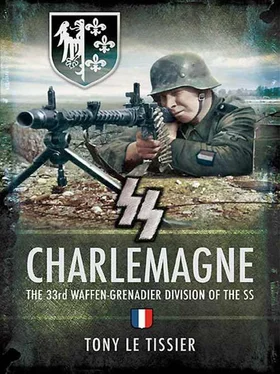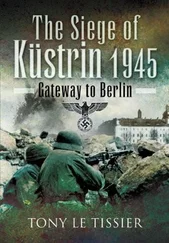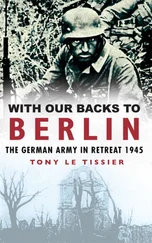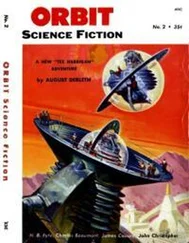As a result of the events of the previous day, the Charlemagne was now re-allocated to General von Tettau’s corps on the 3rd Panzer Army’s eastern wing.
27 February 1945
At about 0100 hours orders were given to embark all the artillery pieces on a train leaving for Belgard, where the Division was to regroup. The 15th SS-Latvian Division as rearguard had been forced back and an incursion by enemy tanks were feared. In fact, the alarm went off at 0300 hours and one could hear the roar of engines and tank tracks. Fortunately, under cover provided by the armoured train from behind the station, the guns were loaded on the available wagons and just as the enemy was launching his first attack at about 0700 hours, the armoured train hitched up the wagons and eventually reached Kolberg via Bublitz and Köslin.
At the same time, as planned, the first elements of the Charlemagne left the barracks, while the panic-stricken civilian population only began leaving just as the first Russian tanks started surrounding Neustettin from the north, cutting the railway line to Kolberg and threatening to turn the retreat into a disaster. The troops had less than an hour in which to winkle their way out. Fortunately, the enemy was none too keen from the beginning and failed to exploit the error of having two regiments concentrated into such a little area.
There was still no news of SS-Major-General Krukenberg, who had been cut off from the bulk of the Division since before Elsenau.
Towards 0800 hours the last units prepared to leave in their turn after the rest of the column, just as Colonel Kropp, the Fortress Commandant of Neustettin and charged with the defence of the town with elements of the Pommern Division of General von Tettau’s corps, came to ask Brigadier Puaud to provide him with a battalion to assist him control the town until evening so as to hold back the enemy to enable the civilian population and those units not engaged to retire. But his constituent battalions had already left, and Brigadier Puaud only had with him some of his headquarters staff, so he gave his liaison officer, Lieutenant Auphan, the task of quickly forming an emergency march battalion from the last units in the column to hold back the enemy and allow the Division to take the field.
In fact, during the early morning, the lights and sounds of fighting coming from northeast of the town could already be distinguished, giving the impression of a more daring approach by the enemy on the bulk of the Division.
Lieutenant Auphan’s improvised march battalion consisted of Second-Lieutenant Fayard’s Flak Company, which had been surprised by the Russian attack as it finished loading its guns on wagons at the station, and had since been employed as infantry, together with the 58th Regiment’s 9th (Tank-Hunting) Company under Sergeant-Major Girard, and Lieutenant Tardan’s 4th Company of the same regiment. These last two units were exhausted from the previous fighting, but there was no other solution. The battalion thus consisted of 3 officers and about 250 men.
Having assessed the situation regarding the Flak Company and established liaison to right and left with the two Wehrmacht battalions between which the French were to be inserted, and having reconnoitred the 1,200m sector assigned to him, Lieutenant Auphan decided that the position could be held by two companies, the Flak in the north and the 4th Company in the south, both companies being reinforced by two sections of tank-hunters armed with Panzerfausts . This deployment would enable him to keep a little reserve of about one-and-a-half sections.
Lieutenant Auphan then ordered the 4th Company, which was deployed near the barracks close to the town’s western exit, to withdraw to the Flak Company’s position on the flank, where it was engaged outside the artillery barracks. When Lieutenant Tardan rejoined Second-Lieutenant Fayard, the latter was having great trouble avoiding enemy fire with the last of his men. By this time the Flak Company had already lost 40 of its 130 effectives. The two companies then occupied the prescribed position in the centre of the deployment.
However, the Russian tanks, stopped about 400m from the town, were covering the anti-tank positions with their fire. It was not until about 2030 hours that aircraft bombed the town and the Russians attempted to infiltrate it. In spite of support from aircraft, artillery and mortars, the Russians were unable to make any progress. The Russian tanks were stopped by the barricades and their infantry infiltrating through the gardens came under murderous fire from riflemen posted on the roofs, in the windows and cellar exits, the whole day passing in extremely violent street fighting.
Finally abandoning the idea of a frontal attack, the enemy then attempted an encircling movement to envelop Neustettin. The French were deployed on the hill outside and enjoyed a relative calm until about 1600 hours, while to the north and south of them the German battalions were in direct contact with the enemy. A territorial battalion was holding the station area in the northern sector, but was fighting without ardour, and the officers had to intervene forcibly several times to make their men hold out. They could not give ground, even though directly menaced and having a line of retreat. In the southern sector, a Russian tank attack succeeded in reaching the barricade on the road from Tempelburg and a furious fight broke out. The Germans knocked out two tanks and the attack was repelled with heavy losses among the Russian infantry. But at 1700 hours the enemy succeeded in taking the bridge across the railway and occupying the station, while in the southern sector their cavalry came round the lake bordering the town on which the defence was anchored. The encirclement had been completed in an hour!
Colonel Kropp, the town commandant, then decided to withdraw his units, starting with the battalion defending the station sector on the left wing, with the battalion on the right wing acting as a rearguard and withdrawing by echelons to the fortified Pommern Stellung line at Barwalde, 10km west of the town, where they would await the withdrawal of other German units to this new line of resistance.
Of this engagement, Lieutenant Auphan later reported:
As soon as the order was received, the battalion on the left retreated in disorder, while the battalion on the right, which was meant to act as the rearguard, did not even wait for the order and pulled out well before my battalion retired last into the town. The rally point was the command post of the German regiment, five kilometres from the town on the Bad Polzin road, where the German colonel was supposed to be expecting his units.
The German colonel had fled with his baggage, abandoning maps, papers and telephone. Soon afterwards the command post was hit by a volley of mortar bombs and bursts of machine-gun fire coming from the direction of the lake.
I therefore decided to follow the retreat to Bärwalde, but two sections sent ahead as scouts reported that the route was already cut by Russians occupying the first village. It was hardly possible to engage them, but the railway line appeared clear, so that was the route decided upon. Pursued by the enemy, the battalion passed through a barrage of missiles, splitting into two detachments, Fayard’s on a railway engine, and Auphan-Tardan’s, which continued on foot.
Both rejoined the Division at Körlin.
Lieutenant Tardan’s report on the same episode ran:
When the fighting stated at the barricade on the Tempelburg road, I left my command post and went forward. Half an hour later, when the fighting had died down, I went back to my command post and found only my liaison staff. The machine-gun section and the mortars that had been kept in reserve had disappeared in the direction of Bad Polzin. There was no one at all at Lieutenant Auphan’s command post!
Читать дальше












